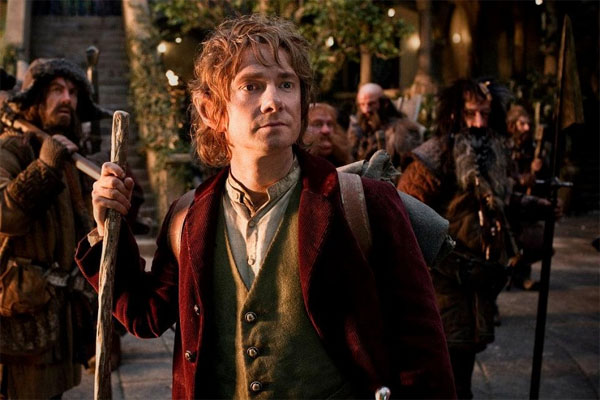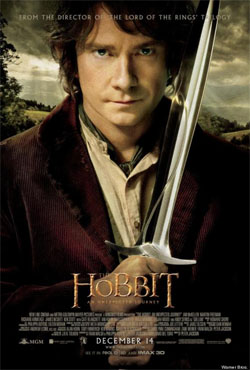 The Hobbit: An Unexpected Journey (2012, Dir. Peter Jackson):
The Hobbit: An Unexpected Journey (2012, Dir. Peter Jackson):
“In the hole in the ground there lived a hobbit. Not a nasty, dirty, wet hole, filled with the ends of worms and an oozy smell, nor yet a dry, bare, sandy hole with nothing in it to sit down on or to eat: it was a hobbit-hole, and that means comfort.”
— J.R.R. Tolkien
Thus begins J.R.R. Tolkien’s The Hobbit, and no one could have anticipated, least of all him, that a children’s tale as compact and homely as a hobbit’s hole would someday become a cinematic extravaganza crammed with all the CGI hordes money can buy, not to mention a testbed for a newfangled high-frame-rate 48P film process, and the start of a film trilogy that will no doubt be around nine hours long, not counting the inevitable director’s cuts…
If that last sentence gives you misgivings, you’re not alone. Director Peter Jackson, who pulled out all the stops in his Lord of the Rings trilogy, must have known that he was setting himself up for an impossible task. His exhaustive and exhausting Ring cycle took delight in exploring every nook and cranny of Middle Earth, before setting it all afire in a conflagration that would have made Wagner blush. Compared to those operatic heights, how could he possibly compose something as gripping from The Hobbit, which at its heart is a cheerful, reassuring tale of dwarves, goblins and dragons, where every ending (except for poor Gollum’s) is a happy one? Having already given us his comprehensive take on the Tolkien universe, where was there left to go but the far white shores of redundancy?
Being a good populist filmmaker, Jackson hedges his bets with The Hobbit — he wants to charm us with adventure in a lower key, while simultaneously continuing to wow us with his scope and technical wizardry. Make no mistake though, “lower key” is all relative; try as he might to not turn the volume up to 11, fairy-tale lightness is not in Jackson’s DNA. Just take the opening of the movie, in which a dwarf kingdom collapses under the onslaught of Smaug the dragon, the camera swooping and diving through scorched caverns of gold, drunk on the production design. Tolkien composed some genial watercolors and sketches for scenes from The Hobbit back in the day, but he would no doubt be dazzled and dizzied by the texture and grit on display here. (Having not seen this movie in 48P, I can’t comment on the state-of-the-art technology Jackson has deployed on this film, but in regular projection some of the scenes are literally a blur.)
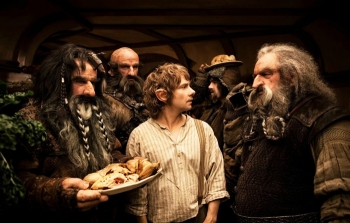 Still, Jackson remains an expert table-setter when it comes to narrative and momentum, and he clearly loves this world and its characters — maybe too much. The opening act, in which the hobbit hole of our hero Bilbo Baggins (Martin Freeman) is invaded by a bakers’ dozen of dwarves led by steely Thorin Oakenshield (Richard Armitage), resulting in Bilbo’s enlistment as a “burglar” to aid them in their quest, is meant to be flippant and droll, with helpful pauses built in whenever one of the bumbling dwarves does something we’re meant to find endearing. But just as he proved in Rings, Jackson is far more comfortable with swords and clubs battering heads than he is with his actors mugging in the name of comedy.
Still, Jackson remains an expert table-setter when it comes to narrative and momentum, and he clearly loves this world and its characters — maybe too much. The opening act, in which the hobbit hole of our hero Bilbo Baggins (Martin Freeman) is invaded by a bakers’ dozen of dwarves led by steely Thorin Oakenshield (Richard Armitage), resulting in Bilbo’s enlistment as a “burglar” to aid them in their quest, is meant to be flippant and droll, with helpful pauses built in whenever one of the bumbling dwarves does something we’re meant to find endearing. But just as he proved in Rings, Jackson is far more comfortable with swords and clubs battering heads than he is with his actors mugging in the name of comedy.
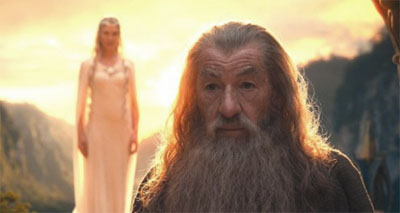 Nonetheless, as our intrepid band, with the help of redoubtable wizard Gandalf (Ian McKellen, more frail but as game as ever) set off on their adventure, there’s little of the portentousness that weighed down Rings. There’s far less homilies and slow-motion shots of tearful faces, and it’s still a pleasure to engage with this world — fittingly enough, Tolkien’s nostalgia for mystical times long gone finds a match with our satisfaction every time we bump into a familiar environment or character. (Look, there’s the elf city of Rivendell! There’s Cate Blanchett once again as Galadriel, as stunning and inclined to uttering doom-laden pronouncements as ever! There’s Christopher Lee as White Wizard Saruman! Careful, he might not be completely trustworthy!)
Nonetheless, as our intrepid band, with the help of redoubtable wizard Gandalf (Ian McKellen, more frail but as game as ever) set off on their adventure, there’s little of the portentousness that weighed down Rings. There’s far less homilies and slow-motion shots of tearful faces, and it’s still a pleasure to engage with this world — fittingly enough, Tolkien’s nostalgia for mystical times long gone finds a match with our satisfaction every time we bump into a familiar environment or character. (Look, there’s the elf city of Rivendell! There’s Cate Blanchett once again as Galadriel, as stunning and inclined to uttering doom-laden pronouncements as ever! There’s Christopher Lee as White Wizard Saruman! Careful, he might not be completely trustworthy!)
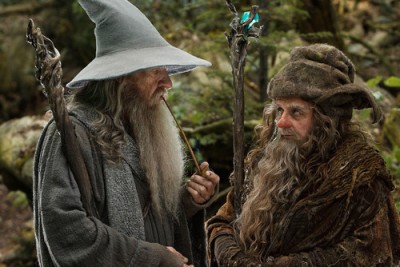 What the film lacks is a spine to hold it all together. In a switch from the original text, the likeable Freeman is a reluctant hero who only proves his worth at the very end of the installment, but that character arc renders Bilbo passive for most of the proceedings, and none of the dwarves stick in the memory, except in terms of how each one’s makeup is unconvincing in its own way. Forced to goose up the narrative to compensate for the character void and accommodate the engorged size of this new trilogy, Jackson throws in characters and situations from other Tolkien works, including the amorphous adventures of bonkers wizard Radagast (Sylvester McCoy) — his rabbit-driven sleigh is off-the-charts nuts, and also the closest this film comes to the zaniness of Jackson’s pre-Rings work. As per usual, Jackson also turns every action scene into a manic flurry of goblins, trolls, orcs and wolves that in their jittery unreality are nice tributes to the work of Ray Harryhausen. When our heroes have to escape from a goblin cavern at the film’s climax, their fight taking them from multi-tiered bridge to bridge, it resembles nothing so much as a bloodthirsty Super Mario game.
What the film lacks is a spine to hold it all together. In a switch from the original text, the likeable Freeman is a reluctant hero who only proves his worth at the very end of the installment, but that character arc renders Bilbo passive for most of the proceedings, and none of the dwarves stick in the memory, except in terms of how each one’s makeup is unconvincing in its own way. Forced to goose up the narrative to compensate for the character void and accommodate the engorged size of this new trilogy, Jackson throws in characters and situations from other Tolkien works, including the amorphous adventures of bonkers wizard Radagast (Sylvester McCoy) — his rabbit-driven sleigh is off-the-charts nuts, and also the closest this film comes to the zaniness of Jackson’s pre-Rings work. As per usual, Jackson also turns every action scene into a manic flurry of goblins, trolls, orcs and wolves that in their jittery unreality are nice tributes to the work of Ray Harryhausen. When our heroes have to escape from a goblin cavern at the film’s climax, their fight taking them from multi-tiered bridge to bridge, it resembles nothing so much as a bloodthirsty Super Mario game.
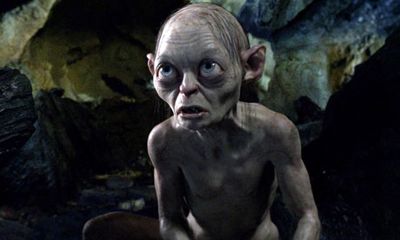 The problem is that we’ve seen all this before. The goblin escape scene is a redux of the Mines of Moria from The Fellowship of the Ring, an over-land assault by orcs is ripped whole-cloth from The Two Towers, and while the CGI has improved over the years, we recognize these scenes for what they are: time-fillers. As the literary predecessor to The Lord of the Rings, The Hobbit had the advantage of being new, and nowhere is that more apparent than when we first meet Gollum (Andy Serkis) in the justly famous “riddles in the dark” scene. It’s the highlight of the movie as well, and yet even here, Jackson strains to outdo everything he’s already done with Gollum in Rings, the camera bobbing and weaving around Bilbo and Gollum, as if afraid we’ll lose interest if we just, you know, observe them. Contrast this with the Ralph Bakshi version, with its languid, sepulchral menace, and it’s obvious that Jackson has sacrificed the cuddle-by-the-fire, yarn-spinning quality of the original story for another bruising bust-up in Middle Earth.
The problem is that we’ve seen all this before. The goblin escape scene is a redux of the Mines of Moria from The Fellowship of the Ring, an over-land assault by orcs is ripped whole-cloth from The Two Towers, and while the CGI has improved over the years, we recognize these scenes for what they are: time-fillers. As the literary predecessor to The Lord of the Rings, The Hobbit had the advantage of being new, and nowhere is that more apparent than when we first meet Gollum (Andy Serkis) in the justly famous “riddles in the dark” scene. It’s the highlight of the movie as well, and yet even here, Jackson strains to outdo everything he’s already done with Gollum in Rings, the camera bobbing and weaving around Bilbo and Gollum, as if afraid we’ll lose interest if we just, you know, observe them. Contrast this with the Ralph Bakshi version, with its languid, sepulchral menace, and it’s obvious that Jackson has sacrificed the cuddle-by-the-fire, yarn-spinning quality of the original story for another bruising bust-up in Middle Earth.
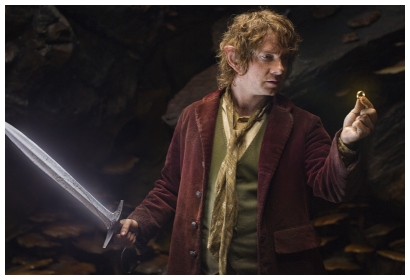 Would the tone of The Hobbit been more spot-on if it had been directed by someone other than Jackson? Possibly, but his vision of Tolkien has become so codified in the minds of audiences and studio execs alike that no one would have likely welcomed a movie that was anything but more of the same. We can be grateful that Jackson respects the material, but by the time this semi-amiable, aimless story ends with a glimpse of Smaug’s impressively animated eye, is there anywhere left to go? Without a Götterdämmerung to give weight to his plot, Jackson’s manic intensity seems to be both too much and not enough. “The world is not in your books and maps,” Gandalf chides Bilbo at one point, and in following the map of his previous work, Jackson has locked himself (and us) in a world that has lost its ability to surprise. Like A.E. Housman’s Shropshire Lad, he may be pursuing the blue remembered hills and happy highways of the past, but as time and cinematic history marches on, they cannot come again.
Would the tone of The Hobbit been more spot-on if it had been directed by someone other than Jackson? Possibly, but his vision of Tolkien has become so codified in the minds of audiences and studio execs alike that no one would have likely welcomed a movie that was anything but more of the same. We can be grateful that Jackson respects the material, but by the time this semi-amiable, aimless story ends with a glimpse of Smaug’s impressively animated eye, is there anywhere left to go? Without a Götterdämmerung to give weight to his plot, Jackson’s manic intensity seems to be both too much and not enough. “The world is not in your books and maps,” Gandalf chides Bilbo at one point, and in following the map of his previous work, Jackson has locked himself (and us) in a world that has lost its ability to surprise. Like A.E. Housman’s Shropshire Lad, he may be pursuing the blue remembered hills and happy highways of the past, but as time and cinematic history marches on, they cannot come again.

